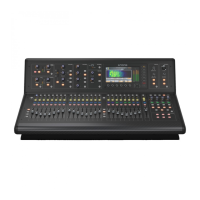82 M32 - Digital Console User Manual 83
Internal Eects
The M32 contains over 60 internal eects that can
be applied to each of the input channels, either as
inserts or as sends and returns. Access the internal
eects by pressing the EFFECTS button next to
the Main Display. The functionality for each of the
eects is detailed below.
Hall Reverb
Classic Hall Reverb simulates the reverberation that occurs when sound is recorded in medium- to large-sized convert
halls. Use the Hall Reverb to give your mix a lush , three-dimensional quality that will make your performance sound
larger than life. Inspired by the Lexicon Hall.
The PRE DELAY slider controls the amount of time before the reverberation is heard following the source signal. DECAY
controls the amount of time it takes for the reverb to dissipate. SIZE controls the perceived size of the space being created
by the reverb eect. The DAMP slider adjust the decay of high frequencies within the reverb tail. DIFF(usion) controls the
initial reection density. SHAPE adjust the contour of the reverberation envelope.
Ambience
Ambience creates a customisable virtual acoustic space in which to place the elements of a mix. Use Ambience to add
warmth and depth without colouring the direct sound. Inspired by the Lexicon Ambience Algorithm.
PRE DELAY sets the time before the reverb follows the source signal. DECAY adjusts the time it takes for the reverb to
completely dissipate. SIZE controls the room size emulation. DAMPING controls the high-frequency decay within the re-
verb tail. DIFFUSE controls the initial echo density. The level sets the volume output of the aected signal. LO CUT aects
the low frequency cut, allowing lower frequencies to remain unaected by the reverb. HI CUT aects the high frequency
cut, allowing higher frequencies to remain unaected by the reverb. MOD adjusts the level of reverb decay modulation.
TAIL GAIN adjusts the volume of the reverb tail.
Rich Plate Reverb
Rich Plate Reverb was originally created by sending a signal through a transducer to create vibrations on a plate of sheet
metal which were then picked up as an audio signal. Our algorithm simulates that sound with high initial diusion and a
bright-coloured sound. Inspired by the Lexicon Plate Reverb.
The PRE DELAY slider controls the amount of time before the reverberation is heard following the source signal. DECAY
controls the amount of time it takes for the reverb to dissipate. SIZE controls the perceived size of the space being created
by the reverb eect. The DAMP slider adjust the decay of high frequencies within the reverb tail. DIFF(usion) controls the
initial reection density. SHAPE adjust the contour of the reverberation envelope.
www.theaudiospecialists.eu

